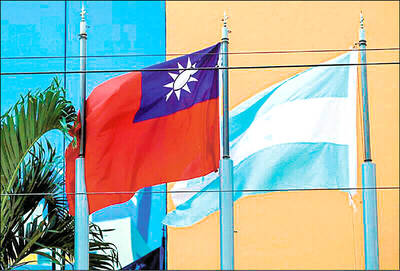The Council of Agriculture yesterday proposed compartmentalizing a major trade conflict with the US regarding the use of a controversial feed additive by easing the ban on imports of beef that contain the substance and keeping in place the ban on pork imports.
“It could be a solution acceptable to both the US and local pig farmers that beef with an acceptable level of ractopamine be allowed into the country, while pork products found to have traces of the banned drug would still be banned,” Council of Agriculture Deputy Minister Hu Sing-hwa (胡興華) said.
The council will present the twin-track proposal at an intergovernmental meeting for the new Cabinet, Hu said.
Hu said this fresh approach would minimize the impact of allowing imports of US beef products that contain traces of ractopamine in terms of public health concerns and complaints from the domestic swine industry.
“It’s not that pork containing ractopamine residues is not safe for human consumption. It does not matter whether it is beef or pork. Meat can safely be eaten as long as the residues remain within the acceptable daily intake levels, but most Taiwanese eat more pork than beef,” Hu said.
“The number of households engaging in pig-raising exceeds 10,000. They rear about 6 million pigs nationwide and pork tops the list of agricultural goods in terms of production value,” he said.
Taiwan is about 95 percent self-sufficient in pork production, while only 7 percent of its beef is locally provided, Hu said.
President Ma Ying-jeou’s (馬英九) administration recently hinted at the possibility of easing the ban on imports of meat containing ractopamine, a growth-promoting drug approved for use in the US and 25 other countries in cattle and hog production, but banned in Taiwan since Oct. 11, 2006.
Hog farmers have opposed any move to lift that ban, as they did in 2007 when the then-Democratic Progressive Party government notified the WTO that it planned to establish a maximum residue level for ractopamine following a risk assessment conducted by the Department of Health.
Taiwan began testing US beef for ractopamine in January last year and demanding that beef found to contain the drug be removed from shelves, prompting the US both to urge Taiwan to meet its WTO commitment and to extend suspension of bilateral talks under the Trade and Investment Framework Agreement (TIFA) halted in 2007 because of the mad cow disease issue.
American Institute in Taiwan Chairman Raymond Burghardt brought up the issue with officials during his visit to Taipei this week.
In response to press queries, Burghardt said resolving the beef issue was a good first step toward Taiwan having a broader and more liberal overall trade posture, vital to its engagement with the to-be-established Trans-Pacific Partnership.
However, the Republic of China Swine Association (ROCSA), a nationwide association of hog farmers, and the Republic of China Cattle Association, have criticized the two-track proposal.
ROCSA deputy director Lin Chiu-kuei (林秋桂) said 18 board members will hold an emergency meeting today to discuss plans to protest the policy.
“The government saying it would only lift the ban on beef was simply a sham to pacify hog farmers. Once it allows ractopamine residue in beef imports, it will also allow residues in pork imports,” Lin said.
Cattle association head Liu San-ho (劉三和) said his group would mobilize its members to protest the policy, which he said would have a serious impact on their industry.

Chinese Nationalist Party (KMT) Chairman Eric Chu (朱立倫), spokeswoman Yang Chih-yu (楊智伃) and Legislator Hsieh Lung-chieh (謝龍介) would be summoned by police for questioning for leading an illegal assembly on Thursday evening last week, Minister of the Interior Liu Shyh-fang (劉世芳) said today. The three KMT officials led an assembly outside the Taipei City Prosecutors’ Office, a restricted area where public assembly is not allowed, protesting the questioning of several KMT staff and searches of KMT headquarters and offices in a recall petition forgery case. Chu, Yang and Hsieh are all suspected of contravening the Assembly and Parade Act (集會遊行法) by holding

PRAISE: Japanese visitor Takashi Kubota said the Taiwanese temple architecture images showcased in the AI Art Gallery were the most impressive displays he saw Taiwan does not have an official pavilion at the World Expo in Osaka, Japan, because of its diplomatic predicament, but the government-backed Tech World pavilion is drawing interest with its unique recreations of works by Taiwanese artists. The pavilion features an artificial intelligence (AI)-based art gallery showcasing works of famous Taiwanese artists from the Japanese colonial period using innovative technologies. Among its main simulated displays are Eastern gouache paintings by Chen Chin (陳進), Lin Yu-shan (林玉山) and Kuo Hsueh-hu (郭雪湖), who were the three young Taiwanese painters selected for the East Asian Painting exhibition in 1927. Gouache is a water-based

Taiwan would welcome the return of Honduras as a diplomatic ally if its next president decides to make such a move, Minister of Foreign Affairs Lin Chia-lung (林佳龍) said yesterday. “Of course, we would welcome Honduras if they want to restore diplomatic ties with Taiwan after their elections,” Lin said at a meeting of the legislature’s Foreign Affairs and National Defense Committee, when asked to comment on statements made by two of the three Honduran presidential candidates during the presidential campaign in the Central American country. Taiwan is paying close attention to the region as a whole in the wake of a

OFF-TARGET: More than 30,000 participants were expected to take part in the Games next month, but only 6,550 foreign and 19,400 Taiwanese athletes have registered Taipei city councilors yesterday blasted the organizers of next month’s World Masters Games over sudden timetable and venue changes, which they said have caused thousands of participants to back out of the international sporting event, among other organizational issues. They also cited visa delays and political interference by China as reasons many foreign athletes are requesting refunds for the event, to be held from May 17 to 30. Jointly organized by the Taipei and New Taipei City governments, the games have been rocked by numerous controversies since preparations began in 2020. Taipei City Councilor Lin Yen-feng (林延鳳) said yesterday that new measures by